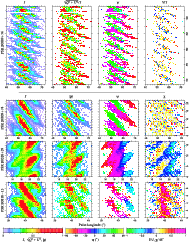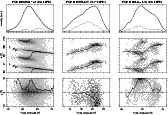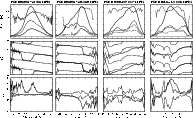 |
Figure 1:
Colour plots of polarimetric subpulse patterns, pulse number
(ordinate) versus pulse longitude (abscissa). The top row shows a
sequence of single pulses PSR B0809+74 at 328 MHz, after
Ramachandran et al. (2002) but now correctly calibrated. The other rows show
mean drift bands, produced by folding the Stokes parameters modulo
subpulse modulation period, and plotted twice for continuity.
From top to bottom: PSR B0809+74 at 328 MHz, PSR B0320+39 at 357 MHz and PSR
B0818-13 at 328 MHz. In the folded plots, a parameterisation of the
polarization that splits it into intensity ( |
| Open with DEXTER | |
In the text
 |
Figure 2:
Polarization histograms. The top panel shows the total
intensity (solid) and polarized intensity (dotted) of the average
pulse profile. The centre panel shows the longitude-dependent
histogram of position angle (plotted twice for continuity) along with
the position angle of the mean profile. The bottom panel shows the
histogram of |
| Open with DEXTER | |
In the text
 |
Figure 3:
Results of eigenanalysis of the covariance matrices. The top
panel shows the average intensity profile (thick solid line), the
square roots of the eigenvalues (solid, dashed, dotted thin lines, in
descending order of value), and the polarization entropy (thick dotted
line). The middle panel shows the position angle of the mean
polarization vector (thick line, plotted repeatedly at offsets of
|
| Open with DEXTER | |
In the text
 |
Figure 4:
Amplitude ( top) and phase ( bottom) of subpulse modulations,
in total intensity (thick solid line) and polarization (semi-major
axis ( |
| Open with DEXTER | |
In the text
| |
Figure 5:
Distribution of polarization orientations in pulse longitudes
39-40 |
| Open with DEXTER | |
In the text
![\begin{figure}
\par\includegraphics[width=5.2cm,clip]{1029f6.eps}
\end{figure}](/articles/aa/full/2004/41/aa1029/Timg64.gif) |
Figure 6:
Illustration of the results of three-way polarization mode
segregation (Deshpande & Rankin 2001) on the superposition of sinusoidal OPMs. a)
Simulated intensity of two OPMs (in a given longitude bin) as a
function of time. b) Resultant signal in the component of |
| Open with DEXTER | |
In the text